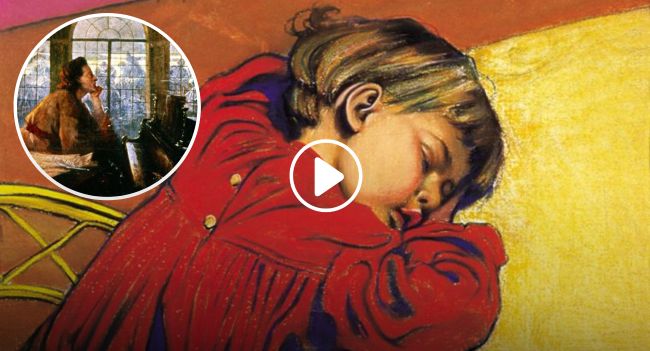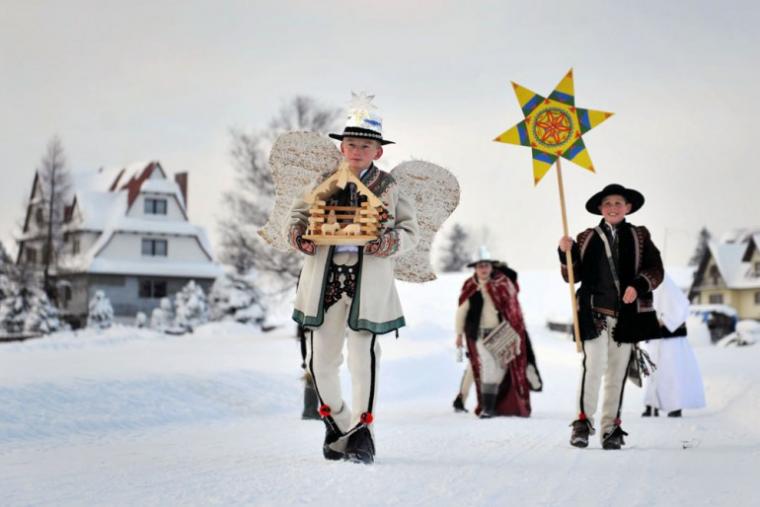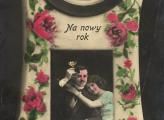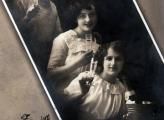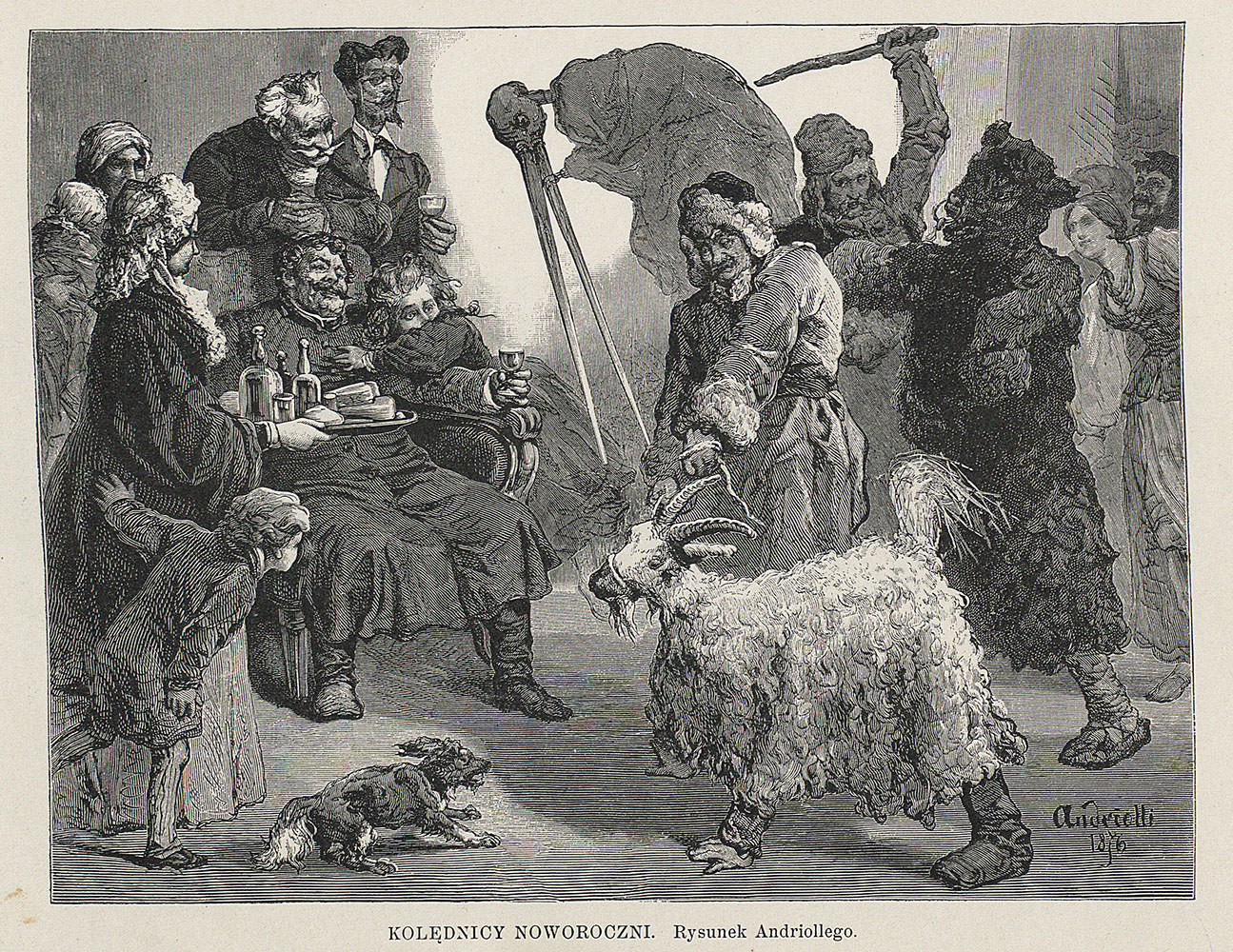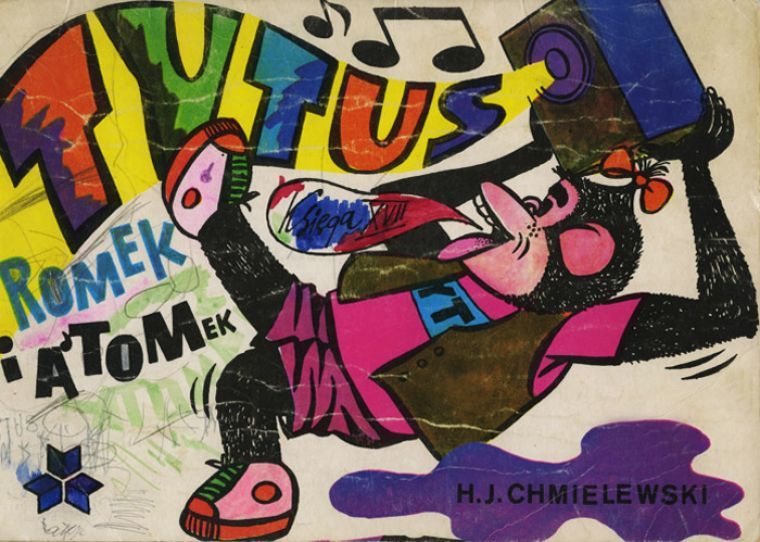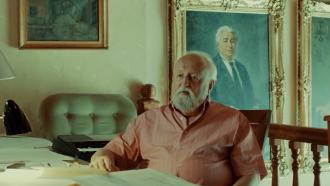In the run-up to Christmas, carols are practically ubiquitous in Poland, just like in other countries. We are almost assailed by them as they crop up in TV adverts and on the radio, in shopping centres and overcrowded buses. But let’s move far away from the commercial tumult, as Culture.pl explores the roots of Polish Christmas carols, as well as the rather unexpected places they have appeared in our history…

Where do Christmas carols come from?
Kolęda, the Polish word for Christmas carol, derives from the Latin Calendae Ianuarie, celebrated in Ancient Rome at the start of each new year, when a new consul would also take up office. People used to exchange seasonal greetings and give each other presents. They would sing songs to greet and praise their hosts when visiting houses, and to symbolise the solar new year. In the territory of modern-day Poland in the 6th and 7th centuries, Slavic peoples practised similar customs (known as Święto Godowe or Szczodre Gody).
With the spread of Christianity, the themes of these songs increasingly revolved around the birth of Christ. Latin hymns were set to music, while new compositions appeared that were unrelated to official church liturgy – pastorałki and carols in local languages. The popularity of Christmas songs was boosted by St Francis of Assisi, initiator of the custom of nativity scenes, from which researchers have traced the roots of many modern carols. The Franciscans came to Poland in the 13th century, and the first carol in Polish dates back to 1424 (unfortunately, its original melody remains unknown).
Keep well, King of Angels,
Who came unto us in human form.
Thou art the true God concealed,
Placed into a holy, pure body.
New Year
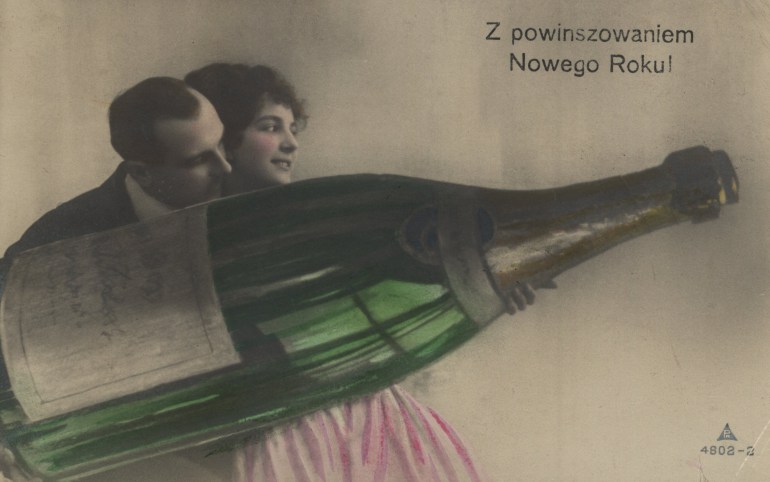
Kolęda had a range of different meanings. Formerly, the word implied a New Year, Christmas Eve or Christmas present, or simply the New Year. Later on, people began ‘carolling’ (going from house to house, passing on good wishes), and priests started paying ‘Christmas calls’ (visiting parishioners in their homes), which often entailed a payment known as a kolęda. There was even a kolęda for cattle: on St. Stephen’s Day (26th December), people used to mix blessed holy wafers into Christmas dishes and feed the sacred mixture to their animals. The historian and ethnographer Zygmunt Gloger wrote in the 1898 edition of his Zwyczaje i Pieśni Doroczne (Annual Traditions and Songs):
Just as flowers adorn the plants and the Earth, so our annual traditions embellish our home lives. They are the legacy of many centuries of community life, something for grandchildren to remember their fathers and grandfathers by.
Trans. MB
The carolling tradition originated in Slavonic and Romanian shepherd culture (colindă in Romanian). Initially, carolling had nothing to do with Christianity, and involved fertility symbols and the exchanging of gifts. The carollers’ animal costumes were relics of ancient rituals (storks, horned beasts named turoń, bears, and other animals associated with strength and fertility), and new costumes arrived along with Christianisation.
‘Herod characters’ began to appear in Christmas and New Year rituals, in reference to the story of Herod the Great massacring the innocents. The words of old carols reflect folk apocrypha and contain references to prejudices, stereotypes, and the social situation (Jews, Roma, Turks, soldiers, and representatives of the authorities). One was described by the literary and Slavonic studies scholar Stanisław Dobrzycki in his book O Kolędach (On Carols) (Warsaw, 1923):
The carol about decoying the Jewish chase is very beautiful […] When the Jews discovered that the Holy Family had escaped, they set off in pursuit, and on the following day,
‘Encountered a farmer in a field, harvesting and bundling sheaves of corn.’
They asked the farmer whether Mary had passed by, and he answered yes. They asked him when.
‘I saw Mary run that way while I was sowing this corn.’
Then the Jews, the carol adds, ‘froze like reeds, bedazzled by the power of God’. The subject of this carol is also known in other countries. There is a particularly beautiful French carol on the same theme.
Trans. MB
Shepherds
The first Polish carols were translated from hymnals of the Unity of the Brethren, a religious movement close to the ideology of the Taborites – a radical faction of the Hussite movement, popular among poor cityfolk and peasants. They regarded the Bible as the only source of law, and strove for complete social equality and mutual sharing of goods. They were named after the city of Tabor in the southern Czech Republic, and one of their leaders was Jan Žižka (a veteran of the Battle of Grunwald). In 1548, when Holy Roman Emperor Ferdinand I, of the Habsburg dynasty, issued an edict forcing members of the Unity of the Brethren either to convert to Catholicism or emigrate, many of them left for Poland. A key element of Czech protestant identity was the importance they accorded to books, and their printing traditions greatly influenced the development of science and culture in Poland (up until the Counter-Reformation and Swedish Deluge, when Leszno, the cradle of the Unity of the Brethren, was burned in 1654 as punishment for supporting the protestant Swedes).
The oldest carol known today is Anioł Pasterzom Mówił (The Angel Spoke to the Shepherds). Its seven stanzas were found in the 16th-century Kórnik manuscript, and its tune comes from a somewhat more recent organ tablature.
The Angel spoke to the shepherds:
Christ is born in Bethlehem,
A town of poor repute.
He is born into poverty,
The Lord of creation.
Trans. MB
Now we should mention pastorałki – the songs with shepherd motifs which are so typical at Christmastime in Poland. The history of the pastorałka dates back to the Baroque period. They describe the birth of Christ and his family’s fate in pastoral style, often with humour, and sometimes even frivolously. Some pastorałki became part of the official Church repertoire, while those deemed too frivolous are still sung in people’s homes, hence their other name: ‘domestic carols’.
Lullabies
The majority of Polish carols which are still sung around the Christmas table were written in the 18th century (although we sing their 19th-century versions). Many of them are lullabies, such as Jezus Malusieńki (Baby Jesus), a carol popularised by Carmelite nuns. The singing of lullaby carols was probably accompanied by the unusual (from a modern point of view) custom of rocking a little Christ figurine. How long this custom has been practised in Poland is unknown. The first sources to mention it date from the 14th century, and it is still performed in some nunneries.
Chopin plays lullabies

One of the fundamental (and symbolic) lullaby carols in Polish musical history is Lulajże Jezuniu (Sleep, Baby Jesus). Fryderyk Chopin included excerpts from this carol in his incredibly emotional and overwhelming Scherzo in B Minor, composed during his stay in Vienna in 1831, his first Christmas spent away from home.
Chopin’s letters from the period are incredibly dramatic. The composer wrote to his friends:
I curse the moment I left… In the salon I pretend to be calm, but on returning home I fulminate at the piano… I return, play, cry, laugh, go to bed, put out the light and dream always of you… Everything I’ve seen thus far abroad seems to me […] unbearable and only makes me long for home, for those blissful moments which I couldn’t appreciate… It seems like a dream, a stupor, that I’m with you…
Trans. MB
In his series of broadcasts The Complete Works of Frédéric Chopin, Mieczysław Tomaszewski said:
Again the music is becalmed in expectation, and we are engulfed in the unrepeatable and unforgettable aura of a Christmas carol – like a voice from another world. The lullaby carol Lulajże Jezuniu is summoned forth, by the strength of recollection, from deep silence and sung with the utmost simplicity, in a luminous B major, accompanied by a discreet ostinato, which reinforces the peace and calm of a Christmas Eve night. And immediately afterwards, a reaction. An original song, in response to the carol. A melody bursting with lyricism swells in an almost beseeching gesture and then falls. The carol subsequently returns several times, entwined in that original song. The sixth time around, it is brutally broken off by a return to reality.
Trans. MB
Who wrote carols?
The majority of the carols’ authors are impossible to determine. These were songs by anonymous carollers, which evolved by word of mouth and, by the time they were written down, probably had very little in common with the originals. A gold mine of folk carols is Lud (Folk) by Oskar Kolberg, which gathers songs from every region of Poland in its dozens of volumes.
Carols written by priests and poets are a different matter altogether. W Żłobie Leży (In a Manger He Lies) was penned by the eminent counter-reformist priest Piotr Skarga, King Vasa’s court preacher. We have the Enlightenment poet Franciszek Karpiński to thank for Bóg Się Rodzi (God is Being Born) – according to tradition, this carol’s tune was borrowed from the King’s Coronation March. While the words to one of the most beautiful carols, Mizerna Cicha (Poor and Quiet), were written by the ethnographer and romantic poet, Teofil Lenartowicz.
Lutosławski wrote carols too
Carols were also familiar to 20th-century composers, with Zygmunt Noskowski and Stanisław Niewiadomski working in the genre, for example. The most interesting pieces, however, were by Witold Lutosławski, whose carols are interspersed throughout this article.
How did Lutosławski – a brave composer who relentlessly sought his own musical language – come to delve into material that, despite being alive and played time and time again by millions of performers, remains completely archaic? The challenge was offered to him by Tadeusz Ochlewski, then director of the Polish Music Publishing House, who commissioned Lutosławski to compose a series of 12 folk tunes. He described the job as ‘composing additional accompaniments for old Polish Christmas carol tunes’.
I gladly accepted the offer, since, in the end, it concerned melodies I had been fond of since my early childhood. The initiator of the series […] Tadeusz Ochlewski, knew perfectly well what to anticipate when commissioning carols from me. He was not expecting practical, conventionally ‘polite’ pieces destined for domestic popularity. Therefore, the controversial reactions my series provoked in its first listeners came as no surprise to him.
Trans. MB
Witold Lutosławski completed the task in 1946, and his series was first performed a year later by Anna Szelmińska (soprano) and Jan Hoffman (piano). To say that Lutosławski’s carols stray from tradition is an inadequate description of the works. After all, Zygmunt Mycielski did have cause to write: ‘It seems that some people simply turn green at the sound of Lutosławski’s carols.’ Włodzimierz Sokorski, the communist minister of culture, even wanted to push him under a tram…
Presumably, this is why Lutosławski’s carols are still not part of the official canon, and are unpopular at music schools (probably due to some rather complex piano). The melodies remain intact, yet his carols abound with new shades, colours, variations and unexpected sounds. Even the most beautiful of carols can end up sounding repetitive and routine, but Lutosławski’s arrangements demonstrate how carols can invoke startling emotions and be a perfect basis for subsequent variations – and why not around the Christmas Eve table?
The clearest example is Bóg Się Rodzi, a highly sentimental carol which can come across as slushy and pompous in popular choral interpretations. Witold Lutosławski’s version is so disturbing and eerie that it could be used for a horror-movie soundtrack.
If you’ve heard your favourite carols too often, know every sound by heart, and are afraid to lose your old fondness for these beautiful songs, we recommend a new Christmas musical journey… It will delight the ears of music aficionados and prompt reflection on the subject of carols – songs we know so well, yet think about so rarely.
Political carols
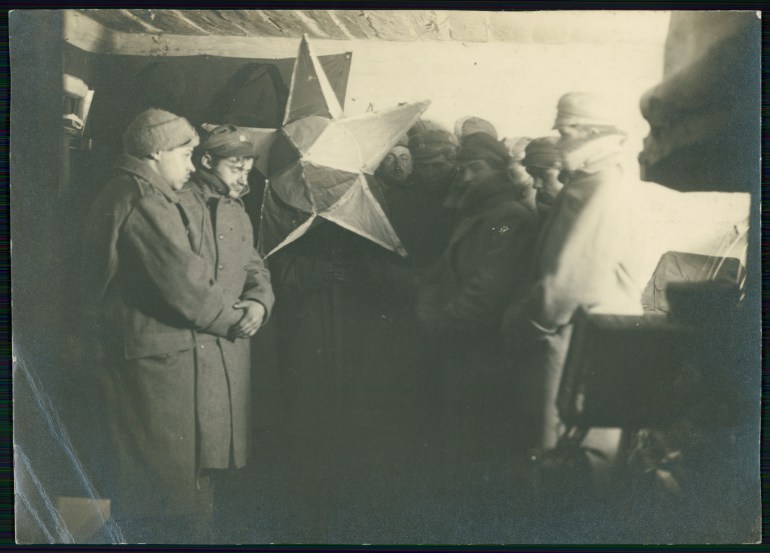
Since we have learned about the historical background of carols, and their ceremonial, social and artistic functions, we should also mention their political role: to comment on current events, build common narratives, and simply cheer us up in difficult times.
Straightforward, catchy carol tunes encourage us to think up our own words for them: a trick used by writers of humoresques (the press used to be full of satirical pieces written in carol form) and social activists from across the political spectrum. As a result, Christmas songs are perfect material for historical research, revealing much about the Polish nation-building process, its martyrdom, and the history of various social groups. Carols stayed with the Polish people from the time of the November Uprising right up until Martial Law.
So far, we have looked at carols from the perspective of peasants (and a few artists), so now it is time for a ‘workers’ carol’ to the tune of Wśród Nocnej Ciszy (In the Still of the Night). It was written by workers from the Koło ceramics factory (still in existence today), and published by the Union of Polish Workers in 1891.
Hey, on the birthday of the Spreader of truth,
Of our Saviour from darkest oppression,
Let us sing merrily, announcing the truth:
Hey, kolęda, kolęda! […]If we, brothers, do not wish to die of hunger,
We all know what is good and what is evil.
Let’s stand shoulder to shoulder, shouting as one:
Hey, kolęda, kolęda!Down with the factory owners and exploiters!
Let’s establish our own new order,
Working together and sharing alike.
Hey, kolęda, kolęda! […]But recall the words of the Saviour,
We are all brothers in the circle of nations.
Harassing the Jews makes no sense.
Hey, kolęda, kolęda!Be they Jews, French, English, Italians, Turks or Germans,
Every human is our brother, not a foreigner.
Let’s love one other and shake each other’s hands.
Hey, kolęda, kolęda!
Trans. MB
Not all carols concern the birth of Jesus; some describe the birth of… a state. In 1918 in Lviv, communities connected with Marshal Piłsudski’s legions published a brochure entitled When Poland is Being Born, A Century after its Execution (to the tune of Bóg Się Rodzi):
A country is being born from tender shoots,
Its leaves are already bursting forth.
Let not envy unite us,
Let not corruption oppress us!
Trans. MB
Poet and cabaret performer Maciej Zembaty wrote a carol while interned in Warsaw’s Białołęka prison during the Martial Law period of the early 1980s. It was sung in a prison corridor by a choir of opposition activists (also to the ever-present tune of Bóg Się Rodzi):
God is being born, and our countrymen,
Are scattered across prisons,
For dreaming of Poland’s
Independence in these lands […]
Mothers, wives, sisters, children
Sit at the Christmas table alone.
Only Satan could arrange
Such a fate for our loved ones.
Trans. MB
Carols as weapons of resistance (& repression)
There’s happy news from London today, from London today.
One thousand bombers, bombers one thousand, flying back from Berlin.
Hitler is raging, Göring is on the run,
Poles are singing and dropping bombs: performing miracles.
Trans. MB
There are countless versions of this carol, which was even sung by popular comic characters Tytus, Romek and A’Tomek when they travelled back in time to the war. Numerous amusing carols emerged in World War II, although joking was not easy amid the turmoil of combat. Carols were rendered in military style, one of the best examples being Żołnierz Drogą Maszerował (The Soldier Marched down the Road), written after the Warsaw Uprising, in a hospital set up for the wounded in Tworki near Pruszków. The words were by an unknown female doctor, sung to the tune of Serce w Plecaku (Heart in a Knapsack):
A soldier was marching down the road,
Through mountains, forests and fields,
The shepherds met him,
And led him to Bethlehem.And even though he was weary,
Onwards he did hasten,
In his knapsack – a gift for the Infant:
A soldier’s heart from Warsaw.
Trans. MB
Singing carols was not always possible, however. On 24th December 1940, the Germans set up a Christmas tree, decorated with electric lights, on the Appellplatz in the Auschwitz concentration camp. Beneath it, they placed the bodies of prisoners who had died of exhaustion and frostbite. Lagerführer Karl Fritzsch called the corpses under the tree ‘a present’, and banned prisoners from singing Polish carols.
Carol singing was also forbidden for Poles incarcerated in Soviet camps. Father Albin Janocha decided to organise Christmas Eve celebrations in a labour camp in Balkhash, Kazakhstan. Apart from Poles, his barrack also housed Lithuanians, Ukrainians and Estonians. After the celebrations, the guards took Janocha to the camp authorities. In the book Pod Opieką Matki Bożej (Under the Heavenly Mother’s Protection), Janocha recalls their reaction.
The head of the ‘political department’ responsible for ideological education was waiting for me, and so began the interrogation. First, I was asked what sort of gathering I’d organised in my barrack. The custodian stated that praying in barracks was banned. When I remarked that there was no mention of prayer being banned in the Camp Head Office regulations posted in every barrack, he replied that the Moscow authorities had clearly… forgotten [to add it].
Trans. MB
Stars on the Star of Bethlehem, or carols & showbiz
From this article, one might conclude that carols were only sung by ancient shepherds exchanging gifts, incarcerated fighters for freedom and independence, camp prisoners, and music-school students. But that is not strictly true, as Christmas songs are also an important branch of the entertainment industry. They have been sung by Czesław Niemen and Chuck Berry, the Beach Boys and Skaldowie, Irena Santor and Eartha Kitt, Wham! and Golec uOrkiestra.
The group Skaldowie were particularly engaged in singing carols, pastorałkas and Christmas tunes, with a repertoire including songs inspired by carols. Będzie Kolęda (Kolęda is Coming) by Andrzej Zieliński, with words by Wojciech Młynarski, featured on their best-selling album Wszystko Mi Mówi, że Mnie Ktoś Pokochał (Everything Tells Me That Somebody Loved Me).
When the band re-formed in the 1990s, they recorded an album entitled Moje Betlejem (My Bethlehem), an hour-long miracle play which they even performed at Poland’s famous Jasna Góra monastery.
What’s curious is that young Polish artists, both in the mainstream and alternative scene, rarely add Christmas carols to their repertoire. In the West, ‘Christmas Music’ is an essential part of the market. Indie and pop stars record genre-bending version of classical carols, write new Christmas tunes or create pastiches. Does the lack of this genre in the Polish market point to the fact that Christmas in Poland is less commercialised than in the West?
Perhaps some percussion or Arabic beats?
How do contemporary musicians interpret carols?
Jerzy Rogiewicz, once a student of Krzysztof Penderecki, is a percussionist, vibraphone player and composer known for his project Jerz Igor and his work with Marcin Masecki. In his album Kolędy (Carols) (Lado ABC, 2018), Rogiewicz arranged classic holiday songs for solo percussion. Where did the idea come from? Many years ago, he listened to his eight-year-old niece play a carol on the drums. The experience moved him; after all, his instrument of choice isn’t one associated with producing melodies.
In Rogiewicz’s carols, we can hear the childlike wonder of discovering new music, creating melodies similar to the ones we used to sing around the Christmas table and enthusiastically discovering new paths. In all honesty, when listening to his recordings, the specific carol isn’t always easy to pinpoint, though this doesn’t take away the participant’s joy from the shared ritual of music. We only hear the solo percussion, but it’s recorded in such a way as to encourage co-creation. We don’t even have to play percussion; simply tapping on the table or hitting the drinking glasses with cutlery is enough. Some tracks contain the echoes of swing time jazz or ragtime music, turning into an uncontrollable effusion of sound. Or vice versa – the songs slowly fade into an unhurried, sentimental narrative. I’m curious how cultural outsiders, those foreign to the tradition of carolling, might interpret these tracks.
Meanwhile, Barbara Kinga Majewska and Marcin Masecki decided to sing Polish carols in Arabic. More specifically, in the dialect used in Aleppo and its neighbouring regions (translations came from Polish-Syrian Szamani Yacoub). The album title Taratil’id al-milad (Bôłt Records, 2018) means ‘Songs for Christmas Day’. The songs were transcribed from major to minor scale, changing once joyful music into something sadder. Majewska and Masecki’s songs aren’t cheerful. In fact, quite the opposite: they come closer to a piercing lament. Above all, these songs remind us that carols are universal, touching on issues that affect the world over. We sing not only of Jesus’ birth, but of wanderers, people in poverty, hunger or cold who are about to give birth.
Did Barbara Kinga Majewska have any difficulty singing in Arabic? In an interview with Anna S. Dębowska, she described the experience:
I spent a long time practicing my pronunciation, the consonants that are foreign to Slavic speakers, especially the ‘h’. The ‘h’ alone has multiple pronunciations in this language, and the difference between them must be audible. I had a wonderful teacher, the same woman who translated these six carols.
